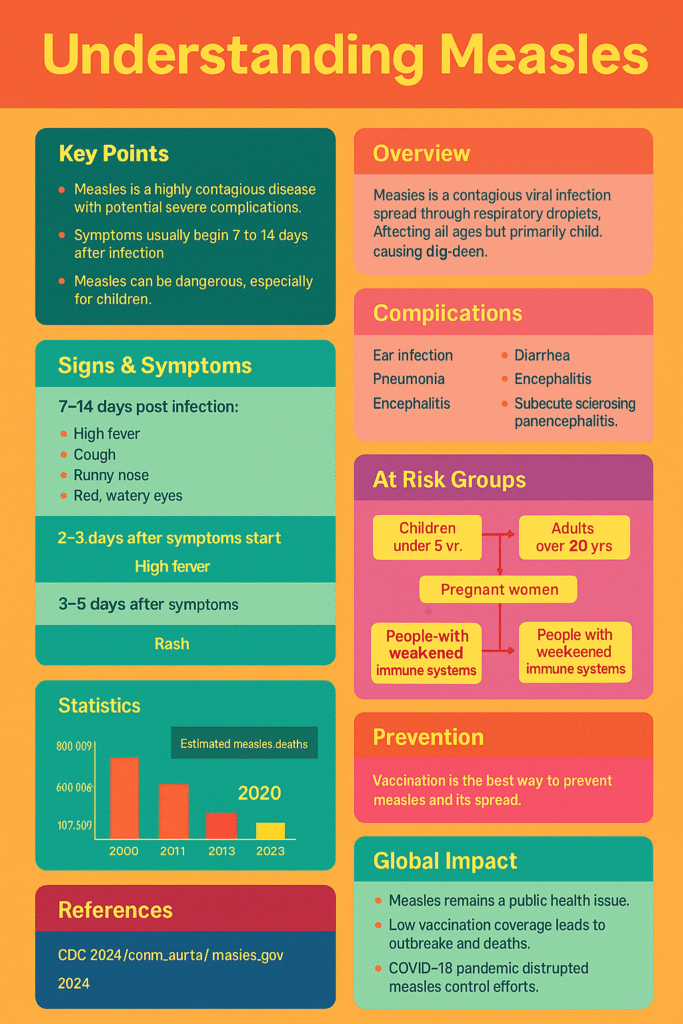Measles (Rubeola)
What is Measles?
Measles is a viral respiratory illness that remains one of the leading causes of childhood death globally. It is highly infectious and spreads rapidly through respiratory droplets. A single infected person can transmit the virus to 90% of nearby unvaccinated individuals.
Transmission & Virus Biology
The measles virus is part of the Morbillivirus genus and is spread through coughing, sneezing, or direct contact with nasal secretions. The virus remains active in the air or on surfaces for up to two hours.
- Incubation: 7–14 days
- Infectious period: 4 days before to 4 days after rash onset
- Mode of transmission: Airborne droplets & contact
Symptoms & Disease Progression
-
Measles progresses in clear stages and presents with a recognizable combination of symptoms. It may also result in post-infectious immune suppression.
- Stage 1 (Prodrome): High fever, cough, runny nose, conjunctivitis
- Stage 2 (Koplik spots): Tiny white lesions inside cheeks
- Stage 3 (Exanthem): Rash starts at hairline and spreads downwards

Who is Most at Risk?
- Children under 5
- Unvaccinated individuals of any age
- Pregnant women
- People with weakened immune systems (HIV, cancer)
- Malnourished children (especially Vitamin A deficiency)
Complications of Measles
Measles can result in several life-threatening complications:
- Pneumonia – leading cause of death in children with measles
- Encephalitis – brain swelling that can cause seizures or disability
- Blindness – especially in Vitamin A deficient children
- SSPE – a fatal degenerative brain disease appearing years later
- Severe diarrhea – leads to dehydration and malnutrition
Diagnosis & Laboratory Testing
Diagnosis involves clinical evaluation followed by confirmation with laboratory tests:
- IgM ELISA: Detects recent infection in blood
- RT-PCR: Detects measles RNA in respiratory specimens or urine
- Genotyping: Helps trace origin of outbreak
- Saliva samples: Common for field surveys
Treatment & Vitamin A Supplementation
No specific antiviral exists for measles. Supportive care is the mainstay of treatment. WHO recommends high-dose Vitamin A for all measles cases.
- Fever and hydration management
- Antibiotics for complications (pneumonia, ear infection)
- Vitamin A: given 24 hours apart, reduces mortality by 50%
- Hospitalization: needed for respiratory failure, malnutrition
| Age Group | Vitamin A Dose |
|---|---|
| Under 6 months | 50,000 IU |
| 6–11 months | 100,000 IU |
| 12 months and older | 200,000 IU |
Prevention & Vaccination
Prevention depends on immunization and public health infrastructure. The MMR vaccine (Measles, Mumps, Rubella) is highly effective and safe.
- First dose: 12–15 months
- Second dose: 4–6 years
- Catch-up campaigns during outbreaks
- MMRV version includes varicella for young children
Global Impact and Outbreak Data
Global resurgence of measles has been fueled by misinformation, reduced vaccination, and healthcare disruptions from COVID-19.
- 107,500 measles deaths globally in 2023
- Over 22 million infants missed their first dose of vaccine
- 884 cases in the US (as of April 2025)
- Outbreaks linked to travel, undervaccinated communities
References
- CDC: Measles Signs, Symptoms, Complications, 2024–2025
- WHO: Measles Elimination Strategy & Vaccine Guidelines
- NHS: Measles Information & Immunization Services
- MedlinePlus: Complications & Long-term Effects